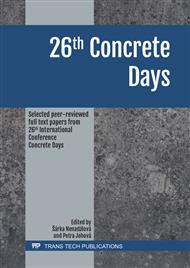p.157
p.163
p.169
p.174
p.180
p.186
p.193
p.201
p.208
Experimental and Numerical Evaluation of UHPFRC Slabs Subjected to Contact and Close-In Explosion
Abstract:
This paper presents achievements in the field of the numerical simulation of the fibrere reinforced concrete (FRC) and ultra-high performance fibre reinforced concrete (UHPFRC). The numerical simulations were performed to verify results of two experimental programmes focused on the blast resistance of FRC and UHPFRC. The response of the FRC and UHPFRC slabs to the contact and near-field blast was studied in these two experiments. As the detail behaviour of specimens could not be observed because of the blast load, the numerical models were prepared. The accuracy of the numerical models was evaluated based on the comparison of numerical and experimental results. Different approaches for blast simulation were tested and compared. The results indicate that the various phenomena (e.g. overpressure propagation, stress cumulation, crack propagation and damage extend) can be successfully simulated. However, the comparison of the soffit velocity, measured with the PDV unit and numerical model showed shortcomings of the numerical model. These numerical model inaccuracies are discussed and their reasons presented.
Info:
Periodical:
Pages:
180-185
Citation:
Online since:
August 2020
Authors:
Keywords:
Price:
Сopyright:
© 2020 Trans Tech Publications Ltd. All Rights Reserved
Share:
Citation:


